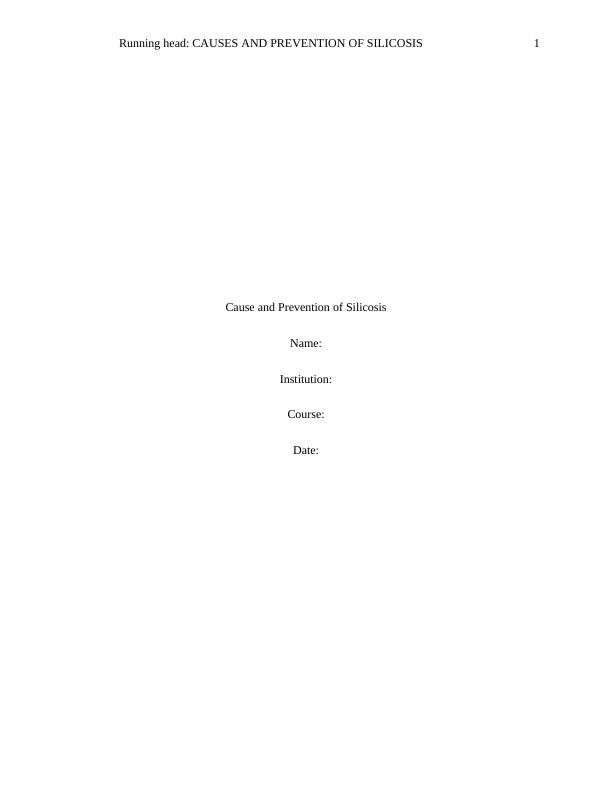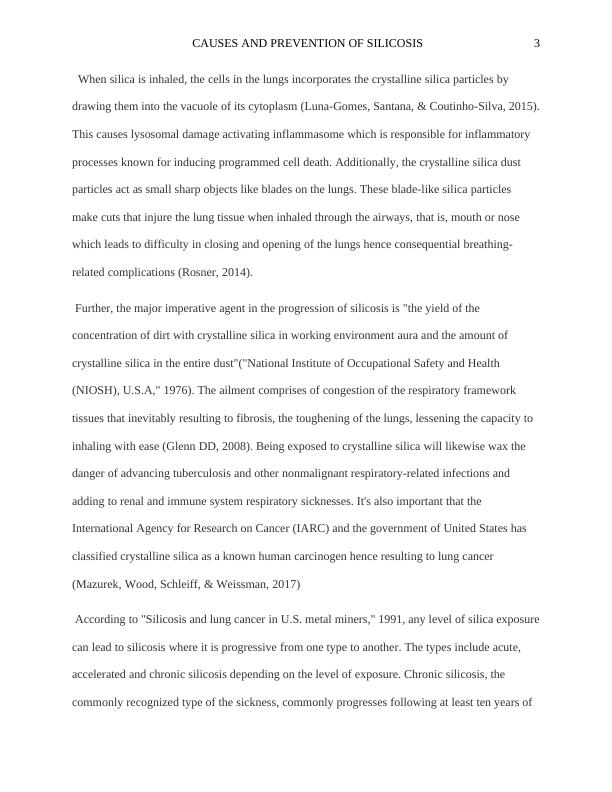Causes and Prevention of Silicosis Assignment
Added on 2020-03-23
13 Pages3530 Words144 Views
Running head: CAUSES AND PREVENTION OF SILICOSIS 1Cause and Prevention of SilicosisName:Institution:Course:Date:

CAUSES AND PREVENTION OF SILICOSIS 2IntroductionSilicosis is a condition caused by inhaling of silica or free crystalline silicon oxide over a period. Silica is composed of quartz and is a common mineral contained in the earth's crust which is commonly found in fine gravel, rock and most metal ores. Inhaling of dirt with crystal like silica is hazardous to human health and has continually proved to be deadly if precautionary measures are not employed. Silicosis is progressive hence may get more severe over time. Symptoms maystart as loss of breath, weakness or an acute cough with other symptoms being chest pain, fever, sweating, weight loss and respiratory breakdown (Breckenridge, 2015). Since this occupational disease is caused by inhaling silicon oxide or silica, people that work in mining, masonry, sandblasting, asphalt manufacturing and glass manufacturing industries just to name a few are at high risk of contracting silica because they deal with silica in their line of work.Literature ReviewSilicosis comes about due to working environment exposing an individual to crystalline silica. This continues all through the world regardless of information on the causes and successful means of counteractive action. Silicosis as occupational diseases is alarmingly high among individuals overexposed to dust in different ventures and occupations, for example, mining, construction, and building maintenance among others. Silicosis is incurable and might be dynamic even after dust exposure has stopped. Hence early recognition and effective mediations are vital. Albeit current ailment is a consequence of past exposures, compelling control of currentwork environment exposures is the best way to prevent continued occurrence of these possibly crippling illnesses. Doctors and professional health caregivers can add to this exertion through precise analysis and give more information on the management and preventive measures of the diseases (Perkins, Peeters, Wouters, Reynaert, & Mossman, 2014).

CAUSES AND PREVENTION OF SILICOSIS 3 When silica is inhaled, the cells in the lungs incorporates the crystalline silica particles by drawing them into the vacuole of its cytoplasm (Luna-Gomes, Santana, & Coutinho-Silva, 2015).This causes lysosomal damage activating inflammasome which is responsible for inflammatory processes known for inducing programmed cell death. Additionally, the crystalline silica dust particles act as small sharp objects like blades on the lungs. These blade-like silica particles make cuts that injure the lung tissue when inhaled through the airways, that is, mouth or nose which leads to difficulty in closing and opening of the lungs hence consequential breathing-related complications (Rosner, 2014). Further, the major imperative agent in the progression of silicosis is "the yield of the concentration of dirt with crystalline silica in working environment aura and the amount of crystalline silica in the entire dust"("National Institute of Occupational Safety and Health (NIOSH), U.S.A," 1976). The ailment comprises of congestion of the respiratory framework tissues that inevitably resulting to fibrosis, the toughening of the lungs, lessening the capacity to inhaling with ease (Glenn DD, 2008). Being exposed to crystalline silica will likewise wax the danger of advancing tuberculosis and other nonmalignant respiratory-related infections and adding to renal and immune system respiratory sicknesses. It's also important that the International Agency for Research on Cancer (IARC) and the government of United States has classified crystalline silica as a known human carcinogen hence resulting to lung cancer (Mazurek, Wood, Schleiff, & Weissman, 2017) According to "Silicosis and lung cancer in U.S. metal miners," 1991, any level of silica exposurecan lead to silicosis where it is progressive from one type to another. The types include acute, accelerated and chronic silicosis depending on the level of exposure. Chronic silicosis, the commonly recognized type of the sickness, commonly progresses following at least ten years of

CAUSES AND PREVENTION OF SILICOSIS 4presentation to moderately low dirt concentration. Accelerated silicosis comes about due to exposure to elevated concentration of silica for a period of 5 to 10-years. Lastly, acute silicosis isan uncommon however exceptionally lethal sickness the source being a concise yet enormous exposure to dust containing crystalline silica with elevated quartz capacity (Esteban, 2004). Silicosis is as old as human activities on the earth's crust. Hence conclusive studies have been done on the ailment giving more insight on it. According to Silicosis Mortality, Prevention, and Control—United States, 1968-2002 (2005), silicosis is an occupational ailment which is preventable but effective treatment of the ailment is yet to be known hence more protective measures should be put in place. The studies show a decline in silicosis death rate in the recent past. Nonetheless, silicosis fatalities and recent conditions still happen in equal proportion to youthful workers. Since effective diagnosis for silicosis is largely unavailable, successful management of crystalline silica exposure in the work environment is vital (Silicosis Deaths Among Young Adults—the United States, 1968-1994, 1998)Recognizing silicosis as a deadly health hazard is an initial step in protecting workers exposed to silica from its exposure, and this should be done by assessing the unrealized ability of employee exposure before beginning a job. Consequently, identifying any job or operation that could lead to exposure of dust is inevitable in seeking to protect the worker from the diseases ("Silica... It's not just dust," 1997). Such a precaution will reduce silicosis mortality and reduce the number of workers contracting the occupational disease and other related respiratory associated sicknesses which are majorly tuberculosis and cancer.Other preventive or precautionary steps in counteracting silicosis according to National Institute for Occupational Safety and Health (NIOSH) include dust control, personal hygiene, protective clothing, air monitoring and respiratory protection. Dust control involves utilizing the dust

End of preview
Want to access all the pages? Upload your documents or become a member.
Related Documents
Silica Dust Properties and Its Effects on Human Healthlg...
|6
|1547
|471
Risk of Lung Cancer in Foundry Workerslg...
|9
|2076
|76
Silica – Technical guide to managing exposure in the workplacelg...
|15
|4912
|17
Assignment on Occupational Healthlg...
|18
|4045
|34
Health Surveillance for Silica Dustlg...
|12
|3701
|38
Occupational Health Surveillance for RCS in Mining Industrylg...
|21
|5228
|334
